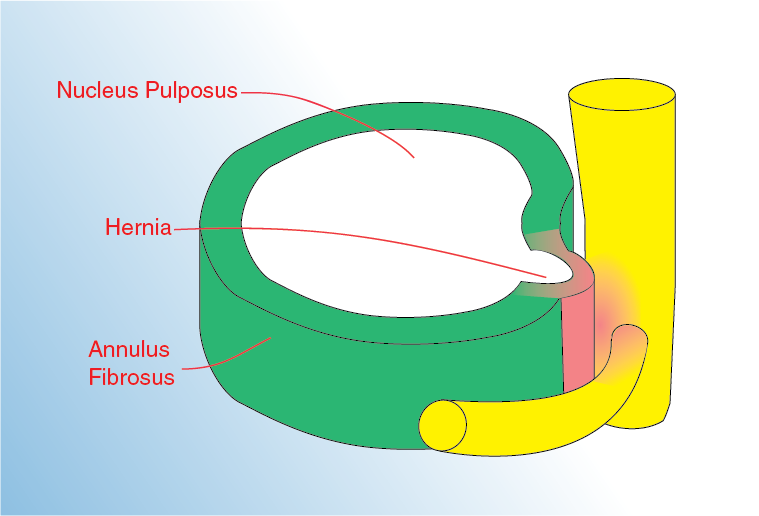There are different types of hernias. The word ‘hernia’ originally means rupture [source?]. The focus of this research is on the Hernia Nuclei Pulposi (HNP) also known as spinal disc hernia or Lumbar disc herniation. This hernia occurs when heavy pressure is applied on one of the intervertebral discs in the human spine, which may occur due to a sudden movement, a fall or when something heavy is lifted. Usually it is referred to as straining one’s back. Although the most often the cause of a hernia is directly linked to aging and degeneration of the the intervertebral disc [1]. This sort of hernia mostly manifests itself in the lower back region, also called the lumbar region and the vertebrae are referred to as lumbar vertebrae.
A spine exists of three different parts: The vertebras, intervertebral discs and the spinal cord. The intervertebral discs contain an outer ring (annulus fibrosus) and a slow liquid inside it (nucleus pulposus) [2]. This liquid enables us humans to tilt and bent our backs. With HNP the liquid has broken the outer ring and makes the ring bulge out into the space of the spinal cord or one of its branches [3]. The spinal cord is the main nerve going from any part of the body to the brain. So besides putting stress on the spinal cord itself, HNP might overload a branch (nerve root) from the spinal cord with stimuli. This results in radiation to other parts of the body (e.g. the legs) [3].
In The Netherlands, if a patient experiences pain due to HNP for a period of 6 months or longer, in most cases, medical procedures are undertaken. The HNP is surgically removed (e.g. by PTED method) and a revalidation period is required. Before this trajectory however, patients might seek additional help to relieve lower back pain or radiation to the legs derived from HNP. Different therapies can be applied to limit the amount of pain, but mostly physiotherapy is recommended [4]. The domains of Osteopathy, Chiropraxia and Manual Therapy all focus on pain originating from the spine but have different ways of treating it. In many countries, including The Netherlands but excluding The United States, these therapies are regarded pseudoscience and considered additional treatments. This is partly due to their history and difficulty in empirically proving their effectiveness [5] but also in part because these are treatments that rely heavily on feeling the pathology and applying pressure in the right places.
[1] Simeone, F.A.; Herkowitz, H.N.; Garfin. Rothman-Simeone, The Spine. ISBN 9780721647777. [2] Butler, Ann B., and William Hodos. Comparative vertebrate neuroanatomy: evolution and adaptation. John Wiley & Sons, 2005. [3] Deyo, R. A., Loeser, J. D., & Bigos, S. J. (1990). Herniated lumbar intervertebral disk. Ann Intern Med, 112(8), 598-603. [4] Erdogmus, C. B., Resch, K. L., Sabitzer, R., Müller, H., Nuhr, M., Schöggl, A., ... & Ebenbichler, G. R. (2007). Physiotherapy-based rehabilitation following disc herniation operation: results of a randomized clinical trial. Spine, 32(19), 2041-2049. [5]https://www.medischcontact.nl/nieuws/laatste-nieuws/artikel/Manuele-therapie-is-kwakzalverij.htm
